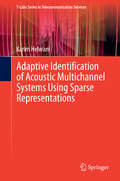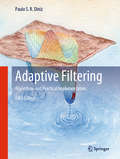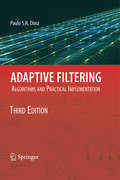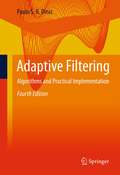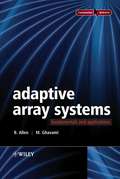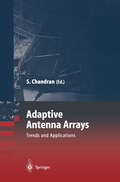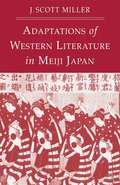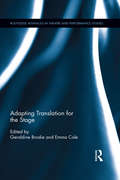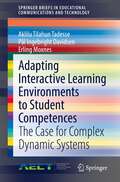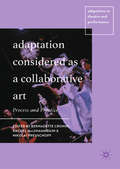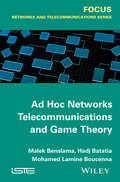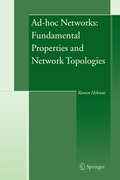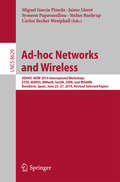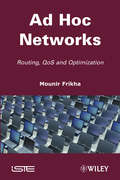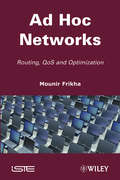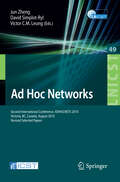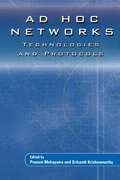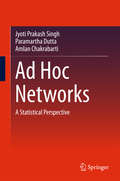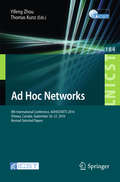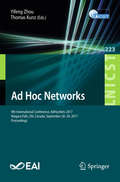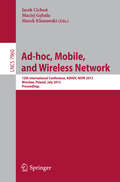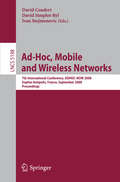- Table View
- List View
Adaptive Identification of Acoustic Multichannel Systems Using Sparse Representations (T-Labs Series in Telecommunication Services)
by Karim HelwaniThis book treats the topic of extending the adaptive filtering theory in the context of massive multichannel systems by taking into account a priori knowledge of the underlying system or signal. The starting point is exploiting the sparseness in acoustic multichannel system in order to solve the non-uniqueness problem with an efficient algorithm for adaptive filtering that does not require any modification of the loudspeaker signals.The book discusses in detail the derivation of general sparse representations of acoustic MIMO systems in signal or system dependent transform domains. Efficient adaptive filtering algorithms in the transform domains are presented and the relation between the signal- and the system-based sparse representations is emphasized. Furthermore, the book presents a novel approach to spatially preprocess the loudspeaker signals in a full-duplex communication system. The idea of the preprocessing is to prevent the echoes from being captured by the microphone array in order to support the AEC system. The preprocessing stage is given as an exemplarily application of a novel unified framework for the synthesis of sound figures. Finally, a multichannel system for the acoustic echo suppression is presented that can be used as a postprocessing stage for removing residual echoes. As first of its kind, it extracts the near-end signal from the microphone signal with a distortionless constraint and without requiring a double-talk detector.
Adaptive Filtering: Algorithms and Practical Implementation (The\springer International Series In Engineering And Computer Science Ser. #694)
by Paulo S. DinizIn the fifth edition of this textbook, author Paulo S.R. Diniz presents updated text on the basic concepts of adaptive signal processing and adaptive filtering. He first introduces the main classes of adaptive filtering algorithms in a unified framework, using clear notations that facilitate actual implementation. Algorithms are described in tables, which are detailed enough to allow the reader to verify the covered concepts. Examples address up-to-date problems drawn from actual applications. Several chapters are expanded and a new chapter ‘Kalman Filtering’ is included. The book provides a concise background on adaptive filtering, including the family of LMS, affine projection, RLS, set-membership algorithms and Kalman filters, as well as nonlinear, sub-band, blind, IIR adaptive filtering, and more. Problems are included at the end of chapters. A MATLAB package is provided so the reader can solve new problems and test algorithms. The book also offers easy access to working algorithms for practicing engineers.
Adaptive Filtering: Algorithms and Practical Implementation
by Paulo S. DinizThis book presents the basic concepts of adaptive signal processing and adaptive filtering in a concise and straightforward manner, using clear notations that facilitate actual implementation. Important algorithms are described in detailed tables which allow the reader to verify learned concepts. The book covers the family of LMS and algorithms as well as set-membership, sub-band, blind, IIR adaptive filtering, and more. The book is also supported by a web page maintained by the author.
Adaptive Filtering: Algorithms and Practical Implementation (The\springer International Series In Engineering And Computer Science Ser. #694)
by Paulo S. DinizIn the fourth edition of Adaptive Filtering: Algorithms and Practical Implementation, author Paulo S.R. Diniz presents the basic concepts of adaptive signal processing and adaptive filtering in a concise and straightforward manner. The main classes of adaptive filtering algorithms are presented in a unified framework, using clear notations that facilitate actual implementation. The main algorithms are described in tables, which are detailed enough to allow the reader to verify the covered concepts. Many examples address problems drawn from actual applications. New material to this edition includes:Analytical and simulation examples in Chapters 4, 5, 6 and 10Appendix E, which summarizes the analysis of set-membership algorithmUpdated problems and referencesProviding a concise background on adaptive filtering, this book covers the family of LMS, affine projection, RLS and data-selective set-membership algorithms as well as nonlinear, sub-band, blind, IIR adaptive filtering, and more.Several problems are included at the end of chapters, and some of these problems address applications. A user-friendly MATLAB package is provided where the reader can easily solve new problems and test algorithms in a quick manner. Additionally, the book provides easy access to working algorithms for practicing engineers.
Adaptive Array Systems: Fundamentals and Applications
by Ben Allen M. GhavamiIn the last fifty years, extensive studies have been carried out worldwide in the field of adaptive array systems. However, far from being a mature technology with little research left to tackle, there is seemingly unlimited scope to develop the fundamental characteristics and applications of adaptive antennas for future 3G and 4G mobile communications systems, ultra wideband wireless and satellite and navigation systems, and this informative text shows you how! Provides an accessible resource on adaptive array fundamentals as well as coverage of adaptive algorithms and advanced topics Analyses the performance of various wideband beamforming techniques in wideband array processing Comprehensively covers implementation issues related to such elements as circular arrays, channel modelling and transmit beam forming, highlighting the challenges facing a designer during the development phase Supports practical implementation considerations with detailed case studies on wideband arrays, radar, sonar and biomedical imaging, terrestrial wireless systems and satellite communication systems Includes examples and problems throughout to aid understanding Companion website features Solutions Manual, Matlab Programs and Electronic versions of some figures Adaptive Array Systems is essential reading for senior undergraduate and postgraduate students and researchers in the field of adaptive array systems. It will also have instant appeal to engineers and designers in industry engaged in developing and deploying the technology. This volume will also be invaluable to those working in radar, sonar and bio-medical applications.
Adaptive Antenna Arrays: Trends and Applications (Signals and Communication Technology)
This compilation of the works and insights of various key scientists and engineers in this area addresses the current and future trends of scenarios for employing adaptive antenna arrays in communication systems. Ideal as a quick reference for engineers, researchers, advanced undergraduate and postgraduate students.
Adaptions of Western Literature in Meiji Japan
by J. MillerThis book examines three examples of late nineteenth-century Japanese adaptations of Western literature: a biography of U.S. Grant recasting him as a Japanese warrior, a Victorian novel reset as oral performance, and an American melodrama redone as a serialized novel promoting the reform of Japanese theater. Written from a comparative perspective, it argues that adaptation (hon'an) was a valid form of contemporary Japanese translation that fostered creative appropriation across many genres and among a diverse group of writers and artists. In addition, it invites readers to reconsider adaptation in the context of translation theory.
Adapting Translation for the Stage (Routledge Advances in Theatre & Performance Studies)
by Geraldine Brodie Emma ColeTranslating for performance is a difficult – and hotly contested – activity. Adapting Translation for the Stage presents a sustained dialogue between scholars, actors, directors, writers, and those working across these boundaries, exploring common themes and issues encountered when writing, staging, and researching translated works. It is organised into four parts, each reflecting on a theatrical genre where translation is regularly practised: The Role of Translation in Rewriting Naturalist Theatre Adapting Classical Drama at the Turn of the Twenty-First Century Translocating Political Activism in Contemporary Theatre Modernist Narratives of Translation in Performance A range of case studies from the National Theatre’s Medea to The Gate Theatre’s Dances of Death and Emily Mann’s The House of Bernarda Alba shed new light on the creative processes inherent in translating for the theatre, destabilising the literal/performable binary to suggest that adaptation and translation can – and do – coexist on stage. Chronicling the many possible intersections between translation theory and practice, Adapting Translation for the Stage offers a unique exploration of the processes of translating, adapting, and relocating work for the theatre.
Adapting Translation for the Stage (Routledge Advances in Theatre & Performance Studies)
by Geraldine Brodie Emma ColeTranslating for performance is a difficult – and hotly contested – activity. Adapting Translation for the Stage presents a sustained dialogue between scholars, actors, directors, writers, and those working across these boundaries, exploring common themes and issues encountered when writing, staging, and researching translated works. It is organised into four parts, each reflecting on a theatrical genre where translation is regularly practised: The Role of Translation in Rewriting Naturalist Theatre Adapting Classical Drama at the Turn of the Twenty-First Century Translocating Political Activism in Contemporary Theatre Modernist Narratives of Translation in Performance A range of case studies from the National Theatre’s Medea to The Gate Theatre’s Dances of Death and Emily Mann’s The House of Bernarda Alba shed new light on the creative processes inherent in translating for the theatre, destabilising the literal/performable binary to suggest that adaptation and translation can – and do – coexist on stage. Chronicling the many possible intersections between translation theory and practice, Adapting Translation for the Stage offers a unique exploration of the processes of translating, adapting, and relocating work for the theatre.
Adapting Interactive Learning Environments to Student Competences: The Case for Complex Dynamic Systems (SpringerBriefs in Educational Communications and Technology)
by Aklilu Tilahun Tadesse Pål Ingebright Davidsen Erling MoxnesThis monograph focuses on the design of personalized and adaptive online interactive learning environment (OILE) to enhance students’ learning in and about complex dynamic systems (CDS). Numerous studies show that students experience difficulties when learning in and about CDS. The difficulties are due to challenges originating from a) the structural complexity of CDS, (b) the production of dynamic behavior from the underlying systems structure, and (c) methods, techniques and tools employed in the analysis of such systems. Despite the fact that studies have uncovered such learning challenges, it is still not well understood how we may effectively address these challenges. In this monograph, the authors provide some answers as to how we may best improve our cognitive capabilities to meet these challenges by way of effective instructional methods, techniques, and tools and their implementation in the form of an OILE. The OILE developed for this purpose, builds on a five-step holistic instructional design framework; identification of instructional design models, identification of authentic learning material, identification of instructional methods, identification of instructional techniques, and design of the interface and implementation of the tool. In this OILE development, six well-documented instructional design models were considered; a four component instructional design, first principles of instruction, constructivists learning environment, task centered instruction, cognitive apprenticeship, and elaboration theory.
Adaptation Considered as a Collaborative Art: Process and Practice (Adaptation in Theatre and Performance)
by Bernadette Cronin Rachel MagShamhráin Nikolai PreuschoffThis book examines the processes of adaptation across a number of intriguing case studies and media. Turning its attention from the 'what' to the 'how' of adaptation, it serves to re-situate the discourse of adaptation studies, moving away from the hypotheses that used to haunt it, such as fidelity, to questions of how texts, authors and other creative practitioners (always understood as a plurality) engage in dialogue with one another across cultures, media, languages, genders and time itself. With fifteen chapters across fields including fine art and theory, drama and theatre, and television, this interdisciplinary volume considers adaptation across the creative and performance arts, with a single focus on the collaborative.
Ad Hoc Networks Telecommunications and Game Theory
by Malek Benslama Mohamed Lamine Boucenna Hadj BatatiaRandom SALOHA and CSMA protocols that are used to access MAC in ad hoc networks are very small compared to the multiple and spontaneous use of the transmission channel. So they have low immunity to the problems of packet collisions. Indeed, the transmission time is the critical factor in the operation of such networks. The simulations demonstrate the positive impact of erasure codes on the throughput of the transmission in ad hoc networks. However, the network still suffers from the intermittency and volatility of its efficiency throughout its operation, and it switches quickly to the saturation zone. In this context, game theory has demonstrated his ability to lead the network to a more efficient equilibrium. This, we were led to propose our model code set that formalizes the behavior of nodes during transmission within SALOHA networks and CSMA respectively.
Ad Hoc Networks Telecommunications and Game Theory
by Malek Benslama Mohamed Lamine Boucenna Hadj BatatiaRandom SALOHA and CSMA protocols that are used to access MAC in ad hoc networks are very small compared to the multiple and spontaneous use of the transmission channel. So they have low immunity to the problems of packet collisions. Indeed, the transmission time is the critical factor in the operation of such networks. The simulations demonstrate the positive impact of erasure codes on the throughput of the transmission in ad hoc networks. However, the network still suffers from the intermittency and volatility of its efficiency throughout its operation, and it switches quickly to the saturation zone. In this context, game theory has demonstrated his ability to lead the network to a more efficient equilibrium. This, we were led to propose our model code set that formalizes the behavior of nodes during transmission within SALOHA networks and CSMA respectively.
Ad-hoc Networks: Fundamental Properties and Network Topologies
by Ramin HekmatThis book provides an original graph theoretical approach to the fundamental properties of wireless mobile ad-hoc networks. This approach is combined with a realistic radio model for physical links between nodes to produce new insight into network characteristics like connectivity, degree distribution, hopcount, interference and capacity. The book establishes directives for designing ad-hoc networks and sensor networks. It will interest the academic community, and engineers who roll out ad-hoc and sensor networks.
Ad-hoc Networks and Wireless: ADHOC-NOW 2014 International Workshops, ETSD, MARSS, MWaoN, SecAN, SSPA, and WiSARN, Benidorm, Spain, June 22--27, 2014, Revised Selected Papers (Lecture Notes in Computer Science #8629)
by Miguel Garcia Pineda Jaime Lloret Symeon Papavassiliou Stefan Ruehrup Carlos Becker WestphallThis book constitutes the refereed proceedings of six workshops collocated with the 13th International Conference on Ad-Hoc Networks and Wireless, ADHOC-NOW Workshops 2014, held in Benidorm, Spain, in June 2014.The 25 revised full papers presented were carefully reviewed and selected from 59 submissions. The papers address the following topics: emerging technologies for smart devices; marine sensors and systems; multimedia wireless ad hoc networks; security in ad hoc networks; smart sensor protocols and algorithms; wireless sensor, actuator and robot networks.
Ad Hoc Networks: Routing, Qos and Optimization
by Mounir FrikhaThis work presents ad hoc networks and their characteristics. It explains a new protocol of routing with QoS as well as its implementation in a network simulator and compares it with the existing protocols. The book discusses the principle of the load balancing, treats the approaches of optimization of energy, and proposes a new approach with an analytical model that gives a better performance.
Ad Hoc Networks: Routing, Qos and Optimization
by Mounir FrikhaThis work presents ad hoc networks and their characteristics. It explains a new protocol of routing with QoS as well as its implementation in a network simulator and compares it with the existing protocols. The book discusses the principle of the load balancing, treats the approaches of optimization of energy, and proposes a new approach with an analytical model that gives a better performance.
Ad Hoc Networks: Second International Conference, ADHOCNETS 2010, Victoria, BC, Canada, August 18-20, 2010, Revised Selected Papers (Lecture Notes of the Institute for Computer Sciences, Social Informatics and Telecommunications Engineering #49)
by Victor Cm Leung Jun Zhi-Zhong David Simplot-RylAd hoc networks, which include a variety of autonomous networks for specific purposes, promise a broad range of civilian, commercial, and military applications. These networks were originally envisioned as collections of autonomous mobile or stationary nodes that dynamically auto-configure themselves into a wireless network without relying on any existing network infrastructure or centralized administration. With the significant advances in the last decade, the concept of ad hoc networks now covers an even broader scope, referring to the many types of autonomous wireless networks designed and deployed for a specific task or function, such as wireless sensor networks, vehicular networks, home networks, and so on. In contrast to the traditional wireless networking paradigm, such networks are all characterized by sporadic connections, highly error-prone communications, distributed autonomous operation, and fragile multi-hop relay paths. The new wireless networking paradigm necessitates reexamination of many established concepts and protocols, and calls for developing a new understanding of fundamental problems such as interference, mobility, connectivity, capacity, and security, among others. While it is essential to advance theoretical research on fundamental and practical research on efficient policies, algorithms and protocols, it is also critical to develop useful applications, experimental prototypes, and real-world deployments to achieve an immediate impact on society for the success of this wireless networking paradigm.
AD HOC NETWORKS: Technologies and Protocols
by Prasant Mohapatra Srikanth KrishnamurthyAD HOC NETWORKS: Technologies and Protocols is a concise in-depth treatment of various constituent components of ad hoc network protocols. It reviews issues related to medium access control, scalable routing, group communications, use of directional/smart antennas, network security, and power management among other topics. The authors examine various technologies that may aid ad hoc networking including the presence of an ability to tune transmission power levels or the deployment of sophisticated smart antennae. Contributors to this volume include experts that have been active in ad hoc network research and have published in the premier conferences and journals in this subject area. AD HOC NETWORKS: Protocols and Technologies will be immensely useful as a reference work to engineers and researchers as well as to advanced level students in the areas of wireless networks, and computer networks.
Ad Hoc Networks: A Statistical Perspective
by Jyoti Prakash Singh Paramartha Dutta Amlan ChakrabartiThis book identifies the time-dependent network parameters: neighbour count, link load, path length, cluster count and delay, and presents a first-of-its-kind discussion on temporal parameters in mobile ad hoc networks. Frequent topology changes and multiple link failures occur in mobile ad hoc network due to arbitrary and random movement of nodes. This dynamic environment challenges the delivery of data and makes it essential to find better models for network parameters that are shifting with time. The parameters identified are put into the framework of time series because of their temporal characteristic, and when they are modelled using time series framework they exhibit a sound fit with Autoregressive AR(p) models of order p. The order p is evaluated for each fitted model and found to lie between one and three. The book also analyses the dependence of end-to-end delay of ad hoc network on various external factors such as the number of nodes, routing protocol, mobility models and path length and develops two prediction models. The book will be useful for researchers and professionals alike.
Ad Hoc Networks: 8th International Conference, ADHOCNETS 2016, Ottawa, Canada, September 26-27, 2016, Revised Selected Papers (Lecture Notes of the Institute for Computer Sciences, Social Informatics and Telecommunications Engineering #184)
by Yifeng Zhou Thomas KunzThis book constitutes the proceedings of the 8th International Conference on Ad Hoc Networks, ADHOCNETS 2016, held in Ottawa, Canada, September 26-17, 2016. The 34 revised full papers presented were carefully reviewed and selected from 46 submissions. The papers provide visions, trends, challenges and opportunities in the area of ad hoc networking and emerging applications. The conference also features two workshops on ad hoc network security and vulnerability, and convergence of wireless directional network systems and software defined networking, respectively.
Ad Hoc Networks: 9th International Conference, AdHocNets 2017, Niagara Falls, ON, Canada, September 28–29, 2017, Proceedings (Lecture Notes of the Institute for Computer Sciences, Social Informatics and Telecommunications Engineering #223)
by Yifeng Zhou Thomas KunzThis book constitutes the refereed proceedings of the 9th International Conference on Ad Hoc Networks, AdHocNets 2017, held in Niagara Falls, Ontario, USA, in September 2017. The 19 full papers were selected from 30 submissions and cover a variety of network paradigms including mobile ad hoc networks (MANETs), sensor networks, vehicular networks, underwater networks, airborne networks, underground networks, personal area networks, device-to-device (D2D) communications in 5G cellular networks, and home networks. The papers present a wide range of applications in civilian, commercial, and military areas.
Ad-Hoc Networking Towards Seamless Communications (Signals and Communication Technology)
by Liljana Gavrilovska Ramjee PrasadThis book reveals the state-of-the-art in wireless ad-hoc networking. It addresses many complex and open problems for researchers in the field of ad hoc networks. It further discusses some of the key research topics that are expected to promote and accelerate the commercial application of these networks (e.g., MAC, routing, QoS, optimization issues, service discovery, traffic models, mobility, handovers, security). It also presents "killer applications".
Ad-hoc, Mobile, and Wireless Networks: 12th International Conference, ADHOC-NOW 2013, Wroclaw, Poland, July 8-10, 2013Proceedings (Lecture Notes in Computer Science #7960)
by Jacek Cichon Maciej Gebala Marek KlonowskiThis book constitutes the thoroughly refereed proceedings of the 12th International Conference on Ad-hoc, Mobile, and Wireless Networks, ADHOC-NOW 2013, held in Wroclaw, Poland, in July 2013. The 27 revised full papers presented were carefully reviewed and selected from 56 submissions. The papers address such diverse topics as routing, rumor spreading, reliability, topology control, security aspects, and the impact of mobility. Some of the papers contain precise analytical results while other ones are devoted to solving specific practical problems of implementation and deployment.
Ad-hoc, Mobile and Wireless Networks: 7th International Conference, ADHOC-NOW 2008, Sophia Antipolis, France, September 10-12, 2008, Proceedings (Lecture Notes in Computer Science #5198)
by David Coudert David Simplot-Ryl Ivan StojmenovicThis book constitutes the refereed proceedings of the 7th International Conference on Ad-Hoc, Mobile, and Wireless Networks, ADHOC-NOW 2008, held in Sophia-Antipolis, France, September 2008. The 40 revised full papers and the 15 poster presentations were carefully reviewed and selected from 110 submissions. The papers deal with advances in Ad-Hoc networks, i.e. wireless, self-organizing systems formed by co-operating nodes within communication range of each other that form temporary networks. Their topology is dynamic, decentralized, ever changing and the nodes may move around arbitrarily.
